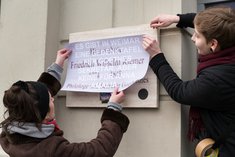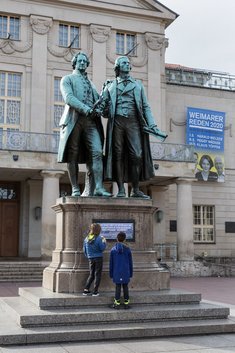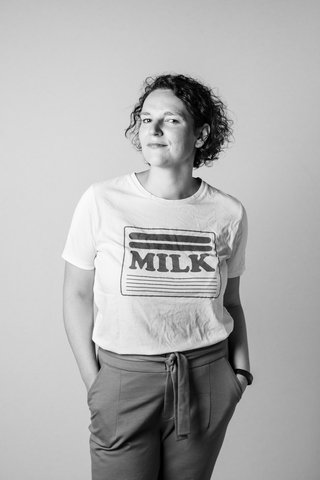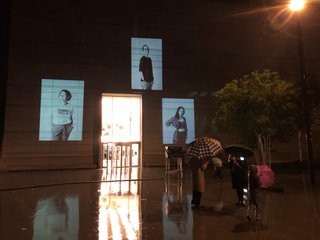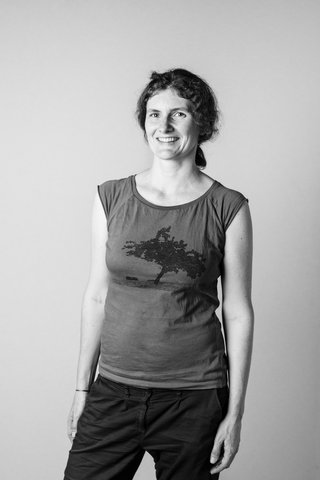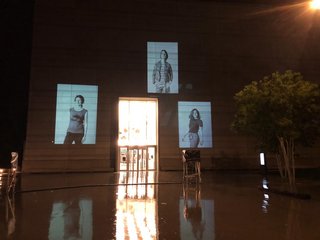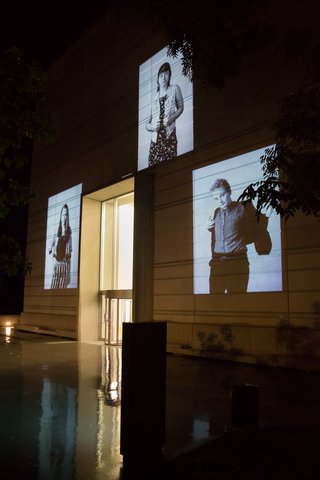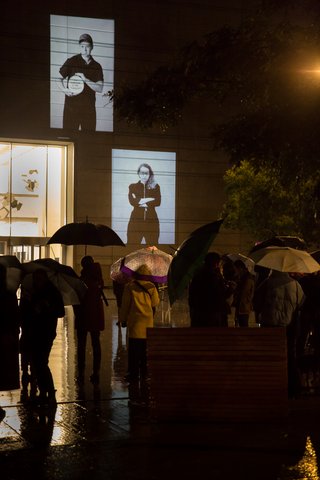How Concept Artist Larissa Barth Writes Women, Trans, Inter, and Non-Binary People into History
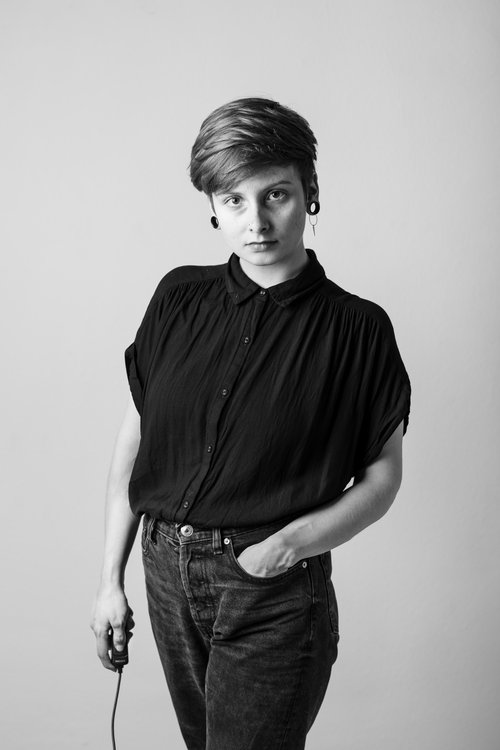
Shortly after nightfall on Saturday 27 September 2020, the Bauhaus Museum Weimar was transformed into a screen for Larissa Barth’s multimedia installation »walter ≠ bauhaus«. Through the use of multiple projectors, the artist cast a series of 108 black-and-white photos onto the west façade of the building, located on Stéphane-Hessel-Platz. Arranged in alternating triads, the photos showed women, trans, inter and non-binary individuals who are currently studying, working or conducting research in connection with the Bauhaus — including Tina Meinhardt (Bauhaus-Universität Weimar Equal Opportunity Officer) and Dr. Miriam Benteler (Bauhaus-Universität Weimar Diversity Officer). Acting as a temporary monument, the larger-than-life portraits projected onto the façade of the Bauhaus Museum represented a counterpart to the representation and reception of the Bauhaus — something that had been previously dominated by cisgender men.
The idea for the photo series »walter ≠ bauhaus« and projecting the images onto the Bauhaus Museum’s façade came to Larissa Barth while she was completing her diploma thesis in the Freie Kunst programme at the Bauhaus-Universität Weimar. Barth says that the theme of her work — »Repräsentation von historischen weiblichen Persönlichkeiten im öffentlichen Raum der Stadt Weimar« (»Representation of Historical Women in the Public Spaces of the City of Weimar«) — was inspired by her time in Weimar: »It came out of simply observing that so much history is represented in the public spaces of Weimar and that women are greatly under-represented. I wanted to examine that more closely, and I also wanted to somehow counterbalance this under-representation of women as well as other gender identities«. Another reason why Barth chose this topic has to do with her observations during the Bauhaus Centenary celebrations in 2020. Examining several of the publications and exhibitions marking the centennial anniversary of the historic Bauhaus, the artist noticed that: »Even one hundred years after the Bauhaus was founded, exhibitions and publications still center famous men like Walter Gropius and Johannes Itten, while mentioning women only as a side-note.«
Two artistic installations grew out of Barth's academic examination of the (under)representation of historical female figures in Weimar: the façade projection photo series »walter ≠ bauhaus« and the »History Repeats (Itself)« initiative.
»History Repeats (Itself)«
For her »History Repeats (Itself)« initiative, Barth erected a commemorative plaque for Anna Amalia, Duchess of Saxony-Weimar-Eisenach, at the library bearing her name at Weimar's Platz der Demokratie. The starting point for this unauthorized public initiative was Barth's realization that there are no monuments or memorial plaques dedicated to Anna Amalia in Weimar or the surrounding area — despite her outstanding political achievements and widely recognized role as a pioneer of Weimar Classicism. Only the name of the library on Weimar’s Platz der Demokratie and the Wittumspalais bear reference to the Duchess.
So Barth decided that she would give Anna Amalia a late tribute herself, while at the same time drawing attention to the general structural under-representation of women in cultural and historical discourse. With support from Sabine Eichholz from the Mould Construction Workshop at the Bauhaus-Universität Weimar, Barth created a commemorative plaque for the duchess. »Unfortunately the mould was not made in Ehringsdorfer travertine, which is customary in Weimar«, admitted Barth, »but in sand-lime brick, which is a similar type of material«. The 60 x 40 cm plaques commemorates the Duchess in the following words:
»In memory of Anna Amalia (24 October 1739 - 10 April 1807) / Duchess of Saxony.Weimar-Eisenach / Pioneer of Weimar Classicism«
The plaques was erected at the entrance to the Duchess Anna Amalia Library at Weimar’s Platz der Demokratie on International Women’s Day on 8 March 2020.
After setting up the plaque, Barth and her partner covered several memorial plaques commemorating the key men of Weimar Classicism with posters. Each poster-image was a blurred version of the original memorial plaque, nevertheless the original subject could still be recognized. Above each image, Barth printed critical messages pointing out the under-representation of women in Weimar's public spaces. On the Goethe and Schiller monument on Weimar’s Theaterplatz, the message read: »There are over 200 memorial plaques in Weimar. Only 24 of them are dedicated to women«. The poster covering the Herder monument’s pedestal, however, read: »Weimar: city of female poets and thinkers«. At the Wieland monument, passers-by learned that: »There is only one monument in Weimar explicitly dedicated to women«. The memorial plaque in Amalienstraße for Goethe's secretary, Friedrich Wilhelm Riemer, was covered by the pointed commentary: »There is a memorial plaque in Weimar for Goethe’s secretary, but none for Anna Amalia«. A supplementary text pointed passers-by towards Barth's commemorative plaque for Anna Amalia.
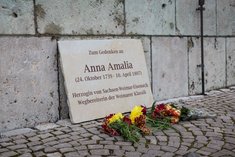
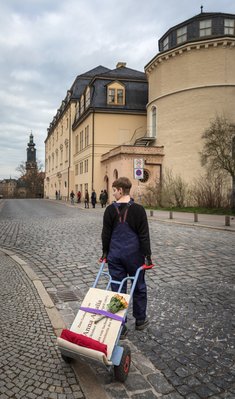
Unfortunately Barth doesn’t know whether passers-by have found their way to the plaque at the Platz der Demokratie because of these posters. »A lot of people have just seen the signs and recognised that this is some kind of initiative. And there have been loads of reactions to these posters. On the Goethe and Schiller memorial at Theaterplatz, for instance, the poster was taken down again and again by people who didn't want it in their tourist photos. I want to also point out that it was mainly men removing the poster, while women posing by the statue sometimes explicitly included the poster in their photos«.
Barth's memorial plaque itself disappeared about three hours after it was erected. A few days before the first corona lockdown, the artist finally contacted the Duchess Anna Amalia Library and learned that staff had taken the plaque into the building to protect it from theft or damage. However, they kept the plaque on display at the library reception desk. »The staff were very enthusiastic about the plaque and contacted the director to ask whether it could be installed permanently«, said Barth, who is currently in talks with the Weimar Klassikstiftung. »It hasn’t been decided yet how the plaque will be displayed, whether it will remain at the reception desk or whether it can be installed in the public space again, as I would like it to be«.
»walter ≠ bauhaus«
In her second artistic initiative, »walter ≠ bauhaus«, Barth dedicated herself to commemorating and remembering the women of the Bauhaus. During her research, Barth recognised how little attention was given to the work and influence of these women — even on campus at the Bauhaus-Universität Weimar: »We have all kinds of busts and sculptures made by and representing men. Some also depict women. Naked women, mostly. In any case, there are no monuments dedicated to the women of the historic Bauhaus«.
During the Bauhaus Centenary celebrations, Barth also recognized that although there is an increasing number of publications and exhibitions that deal specifically with the contributions of women in the Bauhaus movement, »They always remain a niche area into which my photos, admittedly, have to fit as well, namely: ›This is the Bauhaus women’s exhibition in Erfurt‹, for instance, or ›This is book featuring the biographies of Bauhaus women only‹, or ›This is a collection of historic photos of Bauhaus women only‹«. In permanent collections in major museums — for example, the Bauhaus museums in Weimar and Dessau — the recognition that women have received far too little attention in the representation of the Bauhaus movement still isn’t there. To draw attention to this imbalance in the historical representation of the Bauhaus, Barth devised the multimedia project »walter ≠ bauhaus«.
»We’ve been talking about men and the Bauhaus for a century. Walter is dead. Let’s try to change the understanding of Bauhaus!« is how Barth describes her art project in an open call for participation, which she posted on Instagram as well as on posters that she hung throughout Weimar’s city centre and around campus at the Bauhaus-Universität Weimar. Her primary target group were members of the Bauhaus-Universität Weimar, but Barth deliberately extended her call broadly to include individuals who work or carry out research in connection with the Bauhaus. »I would have been open to that«, explained Barth, »because ›Bauhaus‹ is more than just the Bauhaus-Universität in Weimar. It’s not something that can be seen as a homogeneous movement, but rather a label that people feel they belong to«.
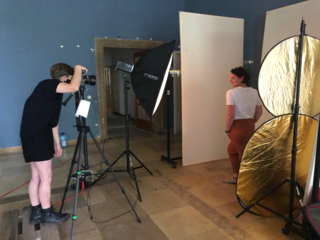
Barth deliberately invited women, trans, inter and non-binary individuals to participate in her project. »There’s no reason for other groups to be under-represented because of their gender identity«, said Barth of this decision. »And there's no good reason to include just women. Why should I exclude, for example, trans people now? Why should they have less of a right to be represented, just because they represent a smaller proportion of the population? This only helps to reinforce under-representation in cases of doubt. All the more effort must be made to remedy this«.
For her public initiative, Barth deliberately chose to create a temporary monument of portrait photographs and façade projection. »Each photo speaks volumes on its subject and creates space and a presence«, she said of her concept. In addition, the photos gave her the opportunity to break through the strict hierarchies of traditional monument making; Participants were selected not by some higher authority, but independently in response to the open call for entries. »I was able to take various photos and leave it up to the individual to decide how they wanted to be portrayed«, said Barth. »That's why I chose the medium of photography — in addition to the possibility of projecting them in public spaces«.
Even before the façade projection at the Bauhaus Museum Weimar, Barth posted parts of her photo series under the Instagram handle @walterisnotequaltobauhaus. For Barth, re/presentation of the photos on Instagram not only represented an additional possibility for intervening in public spaces, it also acted as a contemporary form of the Monument: »Monuments are meant to last forever. I think the internet is a type of permanent place where things don't get lost very quickly«, said Barth. »Much like walking past a monument in a city, you might come across a post from my series on Instagram in your everyday life.«
In addition to the portrait exhibition, the Instagram posts also served as a means to invite more participants to the project. »It was great to see how fast the university community’s awareness of my project grew through the Instagram-page«, explained Barth. »With each photo that I posted, the corresponding circle of people who knew the person portrayed in the photos was informed about my project as well«. The number of followers steadily grew and the account had 450 followers after just two months. Currently the number of followers is at almost 900. »That’s amazing«, said Barth, »And it shows that the under-representation of women, trans, inter and non-binary figures in the Bauhaus is not just something that I recognized, but other people also saw the need to change this«.
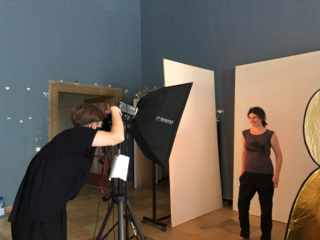
Leading up to her façade projection project at the end of September, Barth was able to photograph 97 people from around the Bauhaus-Universität Weimar for her project. It was especially exciting for Barth »to see who actually feels like they belong here and want to appear in public«. Ten other individuals were unable to make it to Barth’s studio in person, but nevertheless wanted to participate and sent in self-portraits, which Barth projected up onto the Bauhaus Museum along with the portraits she took. Barth also included her own self-portrait in the photo series »walter ≠ bauhaus«.
Barth shot all the portraits following strict corona guidelines in the Altes Funkhaus Weimar, where she had rented studio space. As suggested by the artist, many of the subjects incorporated their own creative ideas into the artistic process. »Some came dressed in their work clothes«, reported Barth. »That made a particularly strong statement. Others came in very eccentric or chic outfits. And some came with a drill hammer. Some came with a particular pose in mind, so they already had a relatively clear idea of how they wanted to be presented in their photo«.
The subjects all had a say in the corresponding photo captions on Instagram. Barth was not just concerned with breaking through the traditional hierarchies of monument creation; for her the personalised self-descriptions of the photo subjects formed another level of personal expression beyond the photos themselves. »I simply believe that it takes more than just a photo to create real representation«, she explained. »This is why I wanted to include a name — where possible — whether that was a pseudonym, full name or first name and the description of the subject’s activities. And since the self-description was open, I didn’t have to refer to a specific job title. The caption could go beyond job title, or even leave it out completely«.
However, including subjects’ names was important to Barth for yet another reason: In her research on the work of women at the historical Bauhaus, she found that a lot of the personal data on the historical Bauhaus had been lost, or not recorded at all — course lists, for instance, with students’ names. This lack of information makes it difficult to trace the artistic biographies of many women at the Bauhaus. Armed with this information, the artist stressed: »I believe that a name — just a name — can contribute to the visibility of women, trans, inter and non-binary people. And I want to make sure that in 100 years’ time, no one will be able to make the statement that ›We just don’t have any information. We don’t have any photos. There just weren’t any famous women. There just weren’t any women who did anything extraordinary. We don’t even know who studied there‹. These statements won't be possible if you look back in 100 years«.
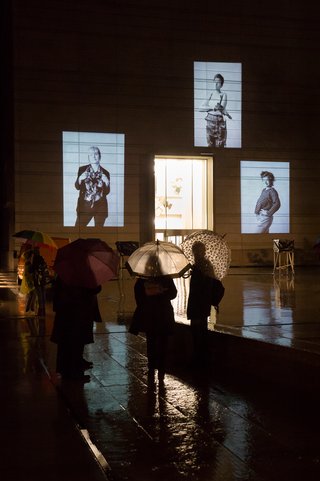
More Information:
Larissa Barth: »History Repeats (Itself)«
https://cargocollective.com/larissa-barth/History-Repeats-Itself
Larissa Barth: »walter ≠ Bauhaus«
https://www.instagram.com/walterisnotequaltobauhaus/
Are you a member of the Bauhaus-Universität Weimar, and are you currently working on a project related to »gender equality«/ »diversity« that we should feature in our newsletter? Then contact us at: michael.wallner[at]uni-weimar.de

